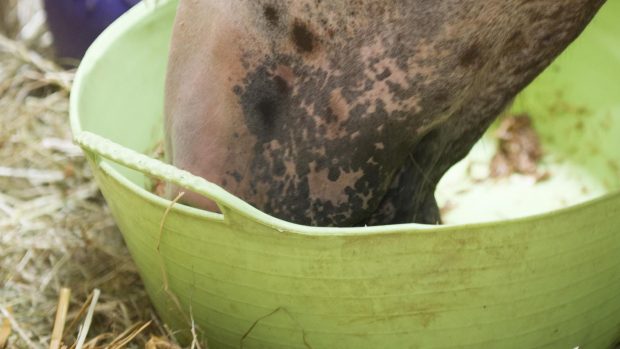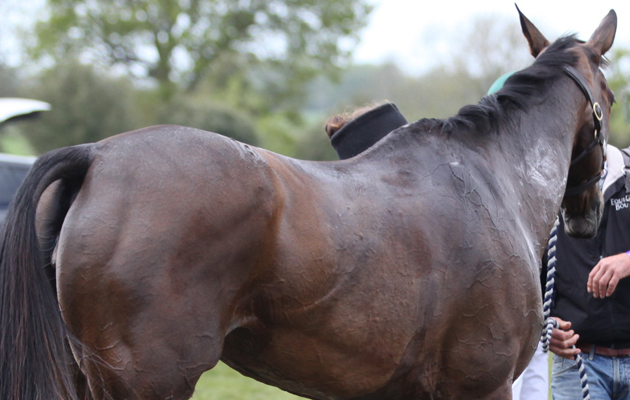An injured horse may be much more difficult to handle at a competition or in the hunting field than if the accident has happened at home.
Whatever the crisis, do not panic. With mobile phones, help can usually be rapidly summoned. Even if the worst happens and your horse is non-weight bearingly lame it will help if you can calmly hold and reassure him. Try to find a confined space to tend to him. If this is not possible, take great care. If the horse is not lame, keep him walking around to avoid a chill, and cover his back and quarters if you can.
Whether you call the vet or not will depend on the nature of the injury, and your own experience. Always have the vet’s telephone number close at hand, no matter where you are and if in doubt, do seek a vet’s advice. Comfort, warmth and food, if available, will help while reinforcements are on their way.
Puncture wound in the foot
Ulrike Kadritzke’s mare Spyder, an 11-year-old Thoroughbred, got a puncture wound when she was out hacking
Ulrike says: “I had just trotted along a byway when my horse suddenly went lame on her left hind. I got off to look and there was masses of blood coming out of her foot.
“I then saw an object sticking into the sole of the hoof that I could not remove. It was a total shock — and I was out by myself, at least 30min away from the yard. My horse couldn’t walk and I did not have any useful phone numbers stored in my mobile phone.
“Luckily another girl from my yard approached, she also had a phone and called the yard, who came to rescue us with a trailer. The vet arrived soon after we got back to the yard. He sedated my mare to pull out the stone, then disinfected the foot and poulticed it. She is now on box rest, will be poulticed for five days, but seems happier putting weight on the foot, so it is likely that the injury was not deep enough to affect her pedal bone.”
A horse with something stuck in the foot should not be walked further to stop the foreign body being pushed deeper into the foot, but this may be impractical. If you have to, remove the object with care, and try to remember exactly where it went into the foot, so you can show the vet. Karen Coumbe
Nosebleed
Charlotte Risius was alarmed when her young event horse Una had a nosebleed soon after finishing her first cross-country
Charlotte says: “My mare, Una, had her first nose bleed after the cross-country phase at her first one-day event, when she was five years old. I was quite alarmed — it continued to bleed for a good hour afterwards.
“Although it was only trickling out of one nostril, I was concerned because she was a laid-back mare and did not seem to get stressed at competitions, so I couldn’t understand why it was happening.
“I got the vet on call at the event to check her out and he seemed unperturbed and said it was just a broken blood vessel. It did happen on a few more occasions, both at home and at competition, but it always stopped after a short while.”
Never try to block the nostrils with anything, such as an icepack, as a horse needs to breathe through its nose. If a nosebleed persists or increases in severity, contact a vet. Recurrent nosebleeds may also need investigation. KC
Sudden lameness
Katie Bisson’s horse, Just Dan, suddenly went lame going across country. She feared it may be a tendon injury
Katie says: “I was competing in a Pony Club one-day event. On a sharp turn in the middle of a combination, Dan went lame.
“I dismounted straight away and couldn’t see any obvious injuries. Dan was still weight-bearing but was far from sound, so I led him back to my lorry and washed off his leg. By then, there was some slight puffiness and heat around his tendon/splint bone area, so I used some cooling gel and bandaged him up. I took him back to the yard and called the vet, who advised me, if it was a tendon issue, to leave it a few days to allow swelling to subside, in order to assess what had happened.
“I cold hosed him twice daily and left him on box rest. He was already more sound when the vet came to assess him, and it turned out Dan had a small splint forming which he must have knocked on that sharp turn, causing the sudden lameness.”
Provided the horse can stand on the limb comfortably, apply a cold bandage or ice pack, if available. Then, when the leg is dry and comfortable, apply a support bandage and travel slowly home by lorry or trailer. If in doubt, speak to your vet at the time. KC
Travel injury
Sara Oakley had to tend to her mare Moneypenny at the roadside after she was injured coming down in a trailer
Sara says: “Moneypenny fell in our trailer on the way home from a show. We unloaded her onto a roundabout, and she had deep cuts to two legs. The only first aid items we had with us were cotton wool, Hibiscrub and water. We poured cold water on to the cuts, and phoned the police and our vet who came straight away.
“The police stopped the traffic and we were able to lead her to a petrol station and on to a grassy area, where our vet sedated her. He then nerve blocked one of her front legs to check the tendon sheath fluid — which fortunately was clear. The vet stitched her cuts and, after another three doses of sedative, we lifted her back into our trailer. She had fully recovered two weeks later.”
Leg wound
David Hodgon’s horse Lisseygen Cruise Clover was wounded when jumping out of water during a hunter trials
David says: “I was competing at Milton Keynes earlier this year when my horse was injured. He’s an ex-Grade B show jumper and has always been actively discouraged from letting his feet touch water. He will jump into water, but it worries him, and he tends to lose impulsion.
“This time, he’d lost so much momentum that we got the jump out of the water wrong. He tripped and dragged his hindlegs up the step. But he wasn’t at all lame and I was unaware he’d been wounded, so we continued.
“When we got back to the horsebox, I saw a round wound on the inside of his hock. Getting near the cut on a 17hh Irish sport horse that had just come off the cross-country was fun!
“I washed the cut with several sterile washes that come in a tube — these allow you to squirt the wound from a distance. Once clean, the cut was covered in Gold Label Wonder Gel, which is great for covering the wound but also washes off easily. It healed quite quickly — he’s a fairly resilient horse.”
Any wound should be considered dirty and will benefit from copious washing with sterile washes or by cold hosing.
Applying a moist wound gel can really help clean and protect a wound. If a wound needs stitching it is best done within six to eight hours after the injury occurs. A vet should be contacted urgently if the wound is associated with severe lameness, especially if it is near any joint or other vital structure. KC



